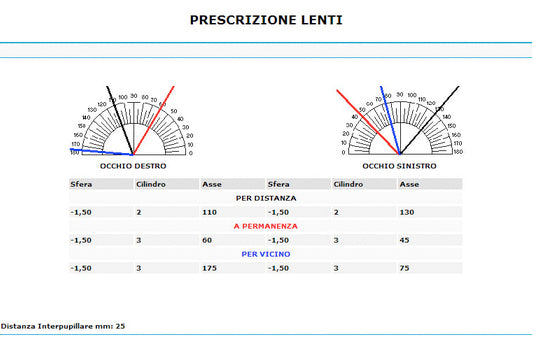How to read an eye prescription
Have you tried to read an ophthalmology prescription but did you not understand anything? No problem, it is not as complicated as it seems, You need some notion just.

Generally the eye requirements are divided by:
- right eye (or)
- Left eye (OS)
- Far
- for close
As you can see from the scheme on the side.
PHASE 1
In this phase we do not consider the two semicircles at the top, but only the data of the part relating to the right eye in the line "for a distance".
- You are myopos If the value indicated in the SF (Sfera) box has a sign -;
- You are hypermetrope if it has a sign +;
– If it is empty or 0 you are Emmetrope (it's not a bad word, it just means you have no defects).
The figure after the sign is the gradation that has the lens: the higher, the greater the defect you have.
PHASE 2
Now let's move on to the box marked by the CIL sign (cylinder): if there is any value it means that you are ASTIGMATIC.
– It is Myopic astigmatism If the SF and CIL values are both -;
– It is Hypermetropic astigmatism If the signs are both +;
– If the signs of the figures in the SF and CIL boxes are different, we almost always speak of Mixed astigmatism.
All clear? Are you still there? Then let's go to the next phase.
PHASE 3
If the box Cil It contains a figure then there will be a value for theAXIS.
This value can go from 0 to 180 degrees and indicates the orientation that the lens must have to work well.
On the two semicircles that we have previously left out graphically the required degrees are graphically indicated. A lens of correct gradation but positioned badly does not correct astigmatism well.
For the left lens we proceed in the same way as the right, and the values can naturally differ from one eye to another.
PHASE 4
View correction Up close.
These values concern subjects who present defects of Presbyopia.
The term will appear on the recipe Add (addition), which indicates the addition of positive diopters to the lenses, to be added to a possible correction for the view from afar.
The value of the alleged for presbyopia concerns only the sphere, normally is the same for both eyes and is always positive even if the resulting value can be negative.
Let's take an example: from afar you have -4,00 while your addition is 1,50: the suitable lens will be -2,50. If instead you have + from afar2,00 and your addition is 1,50 The suitable lens will have value +3,50.
As for the correction values Permanent, almost always have the same indications as those by distance.
This is what. Now you are ready to read your prescription!







